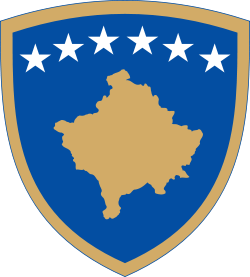Kosovo Polje
| Kosovo Polje | |
|---|---|
| Municipality and city | |
| Косово Поље (Kosovo Polje) Fushë Kosovë | |
|
Train station | |
 Kosovo Polje Location in Kosovo | |
| Coordinates: 42°38′N 21°5′E / 42.633°N 21.083°E | |
| Country | Kosovo[lower-alpha 1] |
| District | District of Pristina |
| Villages | 18 |
| Government | |
| Population (2011) | |
| • Total | 34,827 (municipality)[1] |
| • Density | 412.8/km2 (1,069/sq mi) |
| Time zone | CET (UTC+1) |
| • Summer (DST) | CEST (UTC+2) |
| Postal code | 12000 |
| Area code(s) | +381 38 |
| Car plates | 01 |
| Website | Municipality of Kosovo Polje (ROK) |
Kosovo Polje (in Serbian) or Fushë Kosovë (in Albanian) is a town and municipality in the Pristina district of central Kosovo,[lower-alpha 1]. In 2011 the municipality had a total population of 34,718.
Geography
The town is situated in central Kosovo, some 8 km south-west of Pristina, the capital of Kosovo.
History
Kosovo Polje was named after the site of the 1389 Battle of Kosovo. The settlement of Kosovo Polje was established in 1921 during the Kingdom of Yugoslavia (see Colonisation of Kosovo).[2]
In April 1987, when Slobodan Milošević—then-chairman of the League of Communists of Serbia—was sent to Kosovo Polje's town hall to calm a crowd of angry Serbs protesting what they considered to be anti-Serb discrimination by the Albanian-dominated administration of Kosovo. When Serb citizens complained they had been beaten by ethnic Albanian police in Kosovo, Milošević told them that "No one has the right to beat you [...] No one will beat you ever." The incident earned Milošević the support of the Serbian people, and propelled him to the presidency of Serbia two years later.[3]
Prior to the 1999 Kosovo War, the town of Kosovo Polje had, according to the figures of the Federal Statistical Office in Belgrade from March 1991, a total population of 35,570 inhabitants, while the ethnic makeup was 56.6% Albanian, 23.7% Serb and 19.6% from other communities.[4]
Kosovo Polje saw considerable violence before, during and after the Kosovo War. In December 1998, Serbian deputy mayor of Kosovo Polje Zvonko Bojanić was executed by members of the Kosovo Liberation Army, despite taking a moderate line on Serb-Albanian relations.[5] At the war's end in June 1999, most of the Albanian population returned while many of the town's Serbs were expelled. The remaining Serb population found themselves in an enclave in an Albanian-dominated region. Thousands of Serbs and Roma from other parts of Kosovo, who had fled their homes, took refuge in Kosovo Polje, where a large refugee camp was established.[6] Ethnic tension flared repeatedly in the years after the war and a number of Serbs were killed by Albanian nationalists. Under this continuing pressure, the Serb population of Kosovo Polje shrank steadily until, by July 2002, the newspaper Blic was reporting that only 550 Serbs remained in Kosovo Polje. The town was seriously affected by the March 2004 unrest in Kosovo, which saw almost all Serb inhabitants expelled and their homes burned down.[7] A number are reported to have returned since then and at least some of the destroyed properties have been rebuilt by UNMIK.
Demographics
| Ethnic Composition, Including IDPs | |||||||||||
|---|---|---|---|---|---|---|---|---|---|---|---|
| Year | Albanians | % | Serbs | % | Ashkali | % | Roma | % | Other | % | Total |
| 1991[8] | 20,142 | 56.6 | 8,445 | 23.7 | 6,983 | 19.6 | 35,570 | ||||
| 1998 | 23,600 | 59 | 9,600 | 24 | 40,000 | ||||||
| June 2000 | 34,000 | 84 | 4,000 | 10 | 2,600 | 6.4 | 300 | 0.7 | 60 | 0.14 | 40,500 |
| April 2002[9] | 34,000 | 85 | 3,239 | 8 | 2,259 | 5.6 | 388 | 1 | 21 | 0.05 | 40,000 |
| 2011[1] | 30,275 | 86.9 | 321 | 0.9 | 3,230 | 9.3 | 436 | 1,3 | 565 | 1.6 | 34,827 |
See also
External links
Annotations
- ↑ 1.0 1.1 Kosovo is the subject of a territorial dispute between the Republic of Serbia and the Republic of Kosovo. The latter declared independence on 17 February 2008, but Serbia continues to claim it as part of its own sovereign territory. Kosovo's independence has been recognised by 108 out of 193 United Nations member states.
References
- ↑ 1.0 1.1 "FUSHË KOSOVË/KOSOVO POLJE MUNICIPAL PROFILE March 2014". OSCE Mission in Kosovo. March 2014. p. 1. Retrieved 28 December 2014.
- ↑ Pavlović, Aleksandar. "Prostorni raspored Srba i Crnogoraca kolonizovanih na Kosovo i Metohiju u periodu između 1918. i 1941. godine" (PDF).
- ↑ Vidosav Stevanovic (2004). Milosevic: The People's Tyrant. London: I.B.Tauris. p. 29. ISBN 978-1-86064-842-7.
- ↑ Brunborg, Helge (14 August 2002). "Report on the size and ethnic composition of the population of Kosovo", p. 9. Retrieved February 9, 2015.
- ↑ Tim Judah (2002). Kosovo: War and Revenge. Yale University Press. p. 192. ISBN 978-0-30009-725-2.
- ↑ Peter Bouckaert (2004). Failure to Protect: Anti-minority Violence in Kosovo, March 2004, 16 (6). Human Rights Watch. p. 42.
- ↑ Peter Bouckaert (2004). Failure to Protect: Anti-minority Violence in Kosovo, March 2004 16 (6). Human Rights Watch. pp. 42–43.
- ↑ Brunborg, Helge (14 August 2002). "Report on the size and ethnic composition of the population of Kosovo" (PDF). p. 9. Retrieved 28 December 2014.
- ↑ OSCE (April 2002). "OSCE municipal profile of Fushë Kosovë/Kosovo Polje - April 2002" (PDF). OSCE.
| ||||||
| ||||||||||||||||||||||||||||||||
Coordinates: 42°38′N 21°07′E / 42.63°N 21.12°E
| Wikimedia Commons has media related to Kosovo Polje. |

